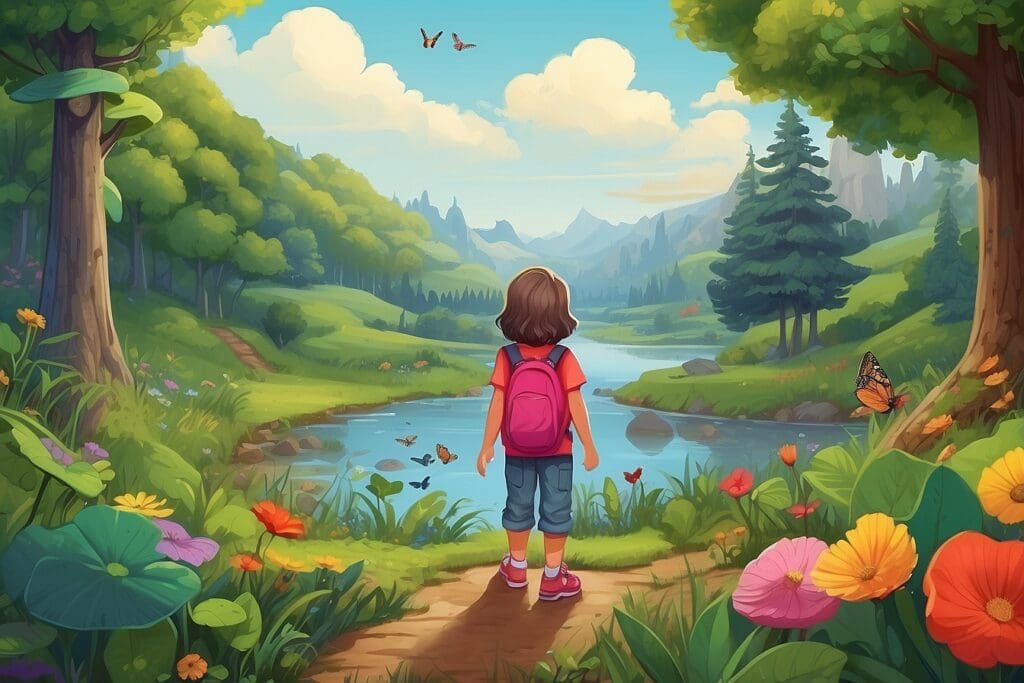Children are suffering from nature-deficit disorder. “I like to play indoors better, ’cause that’s where all the electrical outlets are,” a fourth grader in San Diego once told Richard Louv, author of The Last Child in the Woods.1 Instead of playing in the sun, children are exploring virtual worlds—television, computers, and mobile phones, just for starters. Children are developing these habits at a very early age—on average, preschoolers are exposed to four hours of screen time each weekday.2 Just think, many kids never get to climb a tree, build a secret fort in the forest, or tell stories around a campfire.
According to recent studies, playing in nature improves balance and fitness,3 reasoning and observation skills,4 and collaborative skills.5 It also reduces bullying,6 sickness,7 and Attention deficit hyperactivity disorder (ADHD) symptoms.8 And it inspires children to protect nature9! Richard Louv eloquently describes nature’s benefits for children:

For children, nature comes in many forms. A newborn calf; a pet that lives and dies; a worn path through the woods; a fort nested in stinging nettles; a damp, mysterious edge of a vacant lot—whatever shape nature takes, it offers each child an older, larger world separate from parents. Unlike television, nature does not steal time; it amplifies it. Nature offers healing for a child living in a destructive family or neighborhood. It serves as a blank slate upon which a child draws and reinterprets the culture’s fantasies. Nature inspires creativity in a child by demanding visualization and the full use of the senses. Given a chance, a child will bring the confusion of the world to the woods, wash it in the creek, turn it over to see what lives on the unseen side of that confusion. Nature can frighten a child, too, and this fright serves a purpose. In nature, a child finds freedom, fantasy, and privacy: a place distant from the adult world, a separate peace.10
The “No Child Left Inside” movement began in the United States in response to Louv’s 2005 book. Out of that sprung two Federal bills, the No Child Left Inside Acts of 2008 and of 2009, that aimed to improve outdoor education. Unfortunately, neither bill was enacted into law.11 Today, the No Child Left Inside Coalition is a national group of more than 1,900 organizations that advocates for legislation that ensures basic environmental literacy for every child.12
Organizations Getting Kids Outside! Fortunately, many nonprofit organizations have been helping kids discover the wonders of nature long before “No Child Left Inside” entered our lingo. What’s most inspiring about these programs is that they are accessible to all children, no mater where they live:
Sierra Club’s Inner City Outings (ICO) has been leading wilderness adventures since 1971. Participants include low-income city youth and the physically challenged. Each year, the organization gives about 11,000 young people an opportunity to explore the great outdoors. About 400 volunteers and three part-time staff members keep the program running.13
Outward Bound is comprised of about 40 schools around the world and has about 200,000 participants each year, including at-risk youth. The first school, which opened in Wales in 1941, only loosely resembled today’s Outward Bound program. Back then, the program’s mission was to give young seamen the confidence and perseverance to survive harsh conditions at sea. Today, the organization teaches wilderness survival, leadership, and interpersonal skills through activities such as backpacking, dog sledding, and rock climbing.14
The YMCA offers numerous day and overnight youth outdoor camps to its 45 million members worldwide. The Young Men’s Christian Association began in 1844 with a mission to put Christian values into practice. Today, membership is open to everyone. The outdoor programs vary among local YMCA chapters. To find your local Y camp: ymca.net/find-a-y-camp.
The Appalachian Mountain Club was founded in 1876 by an MIT professor. The first members explored the Appalachian Mountains and built alpine shelters. Now the club is comprised of a dozen chapters, with 450 staff members, 16,000 volunteers, and 100,000 members. AMC maintains over 1,500 miles of trail in the Northeastern United States and leads about 8,000 trips each year. So go hiking, climbing, paddling, you name it!15

These are just a few of the many noteworthy programs running to get children outside exploring nature. There are also many state and local organizations doing good outdoors. Most of these programs are run by volunteers, and they could use your help! Interested in inspiring youth outdoors? Check out these volunteer and paid programs:
Of course, you don’t have to hit the backcountry to show children the wonder of nature. Try these activities with your favorite little ones:
- Schedule screen-free time. That means no computers, no internet, no phones.
- Watch the sunrise and/or the sunset.
- Have a picnic.
- Lay back and look up at the sky.
- building your own greenhouse!
- Go on a hike. The local park is fine. Talk about what you see, hear, smell, touch, maybe even taste.
- If you have access to a backyard with a nice tree, build a treehouse.
- Climb a tree.
- Go on a bike ride!
- Create a fairy village. For inspiration, check out the book Fairy Houses and Beyond! by Barry and Tracy Kane.
- Designate a nature shelf in your home to display your favorite leaves, rocks, and twigs.
- Go birdwatching, and/or put out a bird feeder.
- If your children express interest in exploring nature, encourage them!
For more ideas on how to get kids interested in nature, ask your librarian for the book I love dirt!: 52 Activities to Help You and Your Kids Discover the Wonders of Nature by Jennifer Ward.
No Grown-up Left Inside: Nature is good for adults too of course! It reduces stress and improves your sense of well being. So get out there, and bring the little ones along ☺


